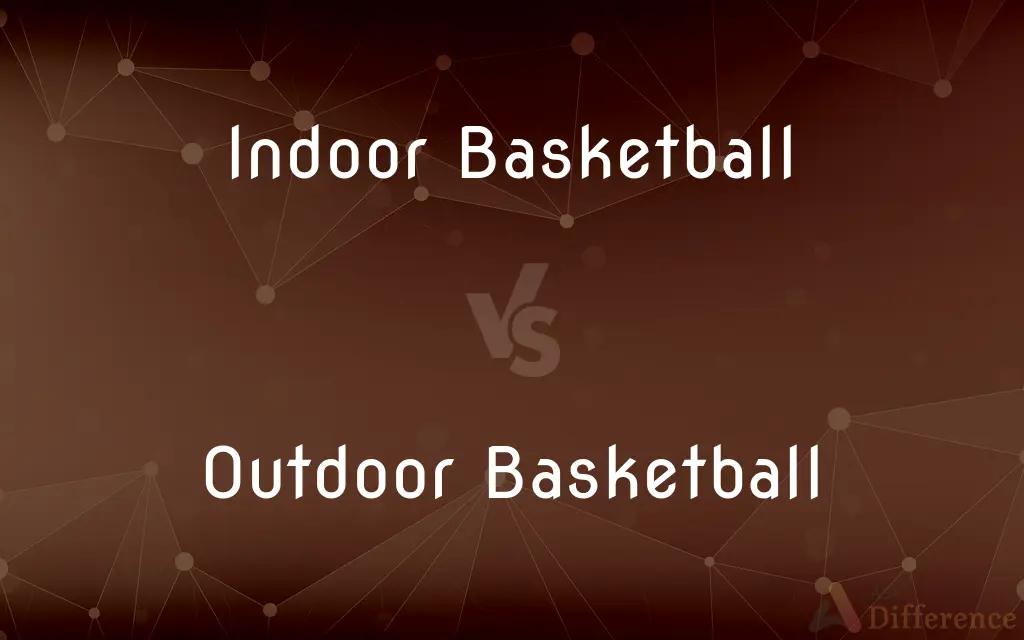Indoor Basketball vs. Outdoor Basketball — What's the Difference?
By Tayyaba Rehman & Urooj Arif — Published on March 4, 2024
Indoor basketballs are typically made of full-grain leather, offering a soft, grippy texture ideal for hardwood courts. Outdoor basketballs are made from durable rubber or composite leather, designed for rough, abrasive surfaces like concrete or asphalt.

Difference Between Indoor Basketball and Outdoor Basketball
Table of Contents
ADVERTISEMENT
Key Differences
The primary distinction between indoor and outdoor basketballs lies in their material and construction, reflecting the different environments they are designed for. Indoor basketballs, crafted from genuine leather, provide a superior feel and grip that improve with use, suited for the smooth surfaces of indoor courts. This leather construction, however, is not durable enough for outdoor conditions, where surfaces are more likely to cause wear and tear.
Outdoor basketballs, on the other hand, are made from tougher materials such as rubber or composite leather. These materials are chosen for their ability to resist damage from rough outdoor surfaces. The texture of outdoor basketballs is also specifically designed to maintain grip in various weather conditions, ensuring consistent performance.
The difference in material also influences the ball's bounce and handling characteristics. Indoor basketballs tend to have a more consistent and controlled bounce on hardwood floors, facilitating precise dribbling and shooting. Outdoor basketballs, designed for less predictable surfaces, have a harder feel and may exhibit a more variable bounce, requiring players to adjust their handling techniques.
Durability is a significant factor in the design of outdoor basketballs. They are constructed to withstand the wear of outdoor play, which includes exposure to dirt, moisture, and rough playing surfaces. Indoor basketballs, while offering optimal performance on indoor courts, require more careful maintenance and are less suited to withstand such conditions.
The choice between an indoor and outdoor basketball often comes down to where the game will be played. Players who primarily play indoors may prefer the feel and performance of a genuine leather ball, while those who play outside will benefit from the durability and weather resistance of rubber or composite balls.
ADVERTISEMENT
Comparison Chart
Material
Full-grain leather
Rubber or composite leather
Surface Compatibility
Hardwood indoor courts
Concrete, asphalt outdoor surfaces
Durability
Lower, sensitive to rough surfaces
Higher, resistant to wear and tear
Feel and Grip
Soft and grippy, improves over time
Harder, designed for grip in all conditions
Bounce and Handling
Consistent on smooth surfaces
More variable, suited for rougher play
Compare with Definitions
Indoor Basketball
Best suited for hardwood courts.
The leather basketball performed best on the polished indoor court.
Outdoor Basketball
Exhibits a harder feel and variable bounce.
The outdoor basketball's bounce was unpredictable on the uneven court.
Indoor Basketball
Requires maintenance to retain quality.
He regularly conditioned his indoor basketball to maintain its grip.
Outdoor Basketball
Designed for rough, outdoor surfaces.
Their rubber basketball survived years of street games.
Indoor Basketball
Made of genuine leather for optimal grip and feel.
The indoor basketball felt soft and responsive during the game.
Outdoor Basketball
Constructed from durable rubber or composite.
The outdoor basketball was tough enough to handle the concrete court.
Indoor Basketball
Offers precise control and consistency.
The indoor basketball's consistent bounce facilitated accurate shooting.
Outdoor Basketball
Maintains grip in various conditions.
The composite basketball offered excellent grip, even on dusty surfaces.
Indoor Basketball
Improves with use, becoming more grippy.
The more they played with the leather basketball, the better its texture became.
Outdoor Basketball
Built to withstand wear and weather.
The durable basketball remained in good condition despite regular outdoor use.
Common Curiosities
Why are indoor basketballs made of leather?
Leather offers a superior grip and feel, enhancing control and performance on smooth indoor courts.
Can I use an indoor basketball outdoors?
While possible, it's not recommended as the rough surfaces will quickly wear down the leather.
How long do outdoor basketballs last?
With proper care, outdoor basketballs can last several years, even with regular use on rough surfaces.
Why do indoor basketballs need more maintenance?
Leather is more sensitive to moisture and dirt, requiring regular cleaning and conditioning to maintain its quality.
Are outdoor basketballs less expensive than indoor ones?
Generally, yes, due to the cost of materials, with rubber being cheaper than genuine leather.
How do I know if a basketball is meant for indoor or outdoor use?
Check the product description; manufacturers typically specify the intended use based on the ball's material.
Do outdoor basketballs perform well on indoor courts?
They can be used indoors, but their harder feel and bounce might not offer the same level of performance as a leather ball.
Can composite leather basketballs be used indoors?
Yes, composite leather basketballs can be used indoors and offer a middle ground between the feel of leather and the durability of rubber.
Is there a significant performance difference between the two types?
Yes, indoor basketballs offer better grip and control on smooth surfaces, while outdoor basketballs are designed for durability and grip in varied conditions.
Why do some players prefer composite leather basketballs?
Composite leather offers a balance of durability for outdoor use with a feel closer to that of genuine leather, suitable for both indoor and outdoor play.
Share Your Discovery

Previous Comparison
Ethyl Nitrite vs. Nitroethane
Next Comparison
Glycol vs. GlyoxalAuthor Spotlight
Written by
Tayyaba RehmanTayyaba Rehman is a distinguished writer, currently serving as a primary contributor to askdifference.com. As a researcher in semantics and etymology, Tayyaba's passion for the complexity of languages and their distinctions has found a perfect home on the platform. Tayyaba delves into the intricacies of language, distinguishing between commonly confused words and phrases, thereby providing clarity for readers worldwide.
Co-written by
Urooj ArifUrooj is a skilled content writer at Ask Difference, known for her exceptional ability to simplify complex topics into engaging and informative content. With a passion for research and a flair for clear, concise writing, she consistently delivers articles that resonate with our diverse audience.
















































